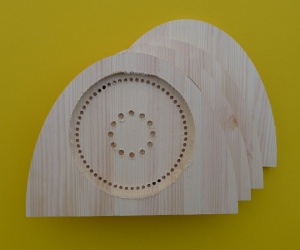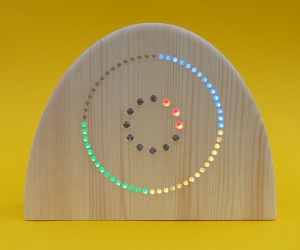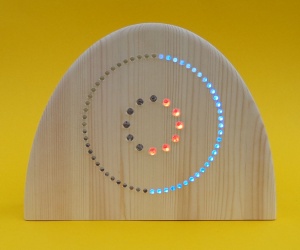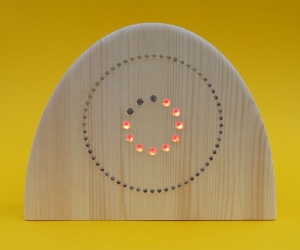|
|
| Zeile 1: |
Zeile 1: |
| | {{Projekt | | {{Projekt |
| | |projectname=CountClock | | |projectname=CountClock |
| − | |subcat=Projects | + | |subcat=Computer, electronics |
| | |Images={{ProjektImages | | |Images={{ProjektImages |
| | |projectimage=30.1.jpg | | |projectimage=30.1.jpg |
| Zeile 14: |
Zeile 14: |
| | }} | | }} |
| | |firstin=https://www.countclock.cc/en/ | | |firstin=https://www.countclock.cc/en/ |
| − | |desc=<div><div><p>CountClock Design for Kids</p><p><b>An intuitive educational clock for easier learning to tell the time.</b></p></div><div><p>CountClock Design for Kids</p><p><b>Programmable learning steps, open source design powered by Arduino.</b></p></div><div><p>CountClock Design for Kids</p><p><b>Clearly separates scales: one for the hours, one for the minutes.</b></p></div><div><h3>CountClock Design</h3><p>Designed for kids (but suitable for all)</p><p>The CountClock is designed to assist young children in learning to tell the time: the confusing concepts of an analogue clock (the double scales and double hands, the numerals (or their absence), the half hours and quarters) are all decomposed and offered as separate learning steps, tuned to young children. Multi-coloured lights indicate time on separate hour and minute scales. For the youngest chlidren for example this results in only presenting the full hours. Just by counting the lights they can read off the hour: knowing the numerals is not needed. In every learning step additional concepts of analogue time can be added, like half hours or quarters. For the older children all minutes including the seconds can be highlighted; in this highest learning level the looks of the CountClock closely approximate a conventional analogue clock. No kids around? Don't worry, the CountClock perfectly serves as a design clock, suitable for anybody who'd like to know the time</p><br/><br/><div><h3>Small CountClock: Hours Only</h3><p>Go to bed when seven lights are on ~ Stay in bed until seven lights are on</p><p>The Small CountClock shows only the full hour by hightlighting up to twelve multi-colored lights, positioned on a circle. It's either one o'clock or two o' clock: nothing in between. An important educational aspect is that the lights of the passed hours remain on: this allows to count up to the current hour by counting the lights. That's why the design is called CountClock.</p><br/><div><h3>Large CountClock: Hours and Minutes</h3><p>Seven learning levels towards telling the time</p><p>The large CountClock has a small circle with twelve multi-colored lights for the hours and around it another ring of sixty multi-colored lights showing the minutes. This CountClock version has seven learning levels: Learning level 1 only shows the hours. Again: the fact that the passed hours remain on is a crucial educational aspect, which allow to find out the current hour by counting. Learning level 2 indicates the full and half hours. In this level the half hour is presented as a joined section, with all minute-lights 1 to 30 switched on in the same colour. The underlying idea is that this makes the half-hour an entity. Learning level 3 shows quarters in 15-minute sections: each quarter in a different colour to clearly separate each quarter, but also to underline that two quarters together build up the half hour (the half hour is a lesson from learning level 2). Learning level 4 shows the minutes divided into 10-minute sections and learning level 5 shows the minutes divided into 5-minute sections. Learning level 6 shows the hours and all the minutes (and all minutes passed remain on in this level), including a blinking light for the second. The display mode in learning level 7 approaches the looks of a conventional analogue clock: a single light on the inner circle indicates the hour and on the outer circle only the current minute is highlighted. A blinking light for the second circles over the large ring. The aid of counting the lights is absent in this highest learning level, which makes the switch to reading off an analogue clock really easy.</p><br/><br/><div><h3>Open Source Design</h3><p>If you can't open it, you don't own it</p><p>As the CountClock is an open source design the user is in full control of the device and also the programme code may be modified to meet personal preferences. The electronics are based on the open source Arduino, with the most important components being the reprogrammable controller, LEDs and a timer module. The software to modify the programme code likewise is open source and can be . The CountClock itself may be opened using tools to investigate it and to adapt or repair it. The design files of the CounClock housing and its protective electronics mounting disc are available below. Hint: open the svg source files in a new browsertab ('open link in new tab'). The Arduino program code is still to be published.</p>To be published: Programme Code Small To be published: Programme Code Large<div><h3>Get a CountClock</h3><p>Buy a CountClock or make one yourself</p><br/><p>All CountClock technical drawings are freely available, so it is possible to make one yourself. The wooden CountClock housings (both the small and the large one) are also separately for sale, which spares the bother of the home-making and guarantees a high manufacturing quality. The measures: the small CountClock has a base of 16 cm (height 12 cm), the large one 29 cm (height 22 cm).</p><ul><li>Large CountClock (hours & minutes)complete & functional: EUR 600</li><li>Large CountClock (hours & minutes)casing only: EUR 250Caution: only for makers</li><li>Small CountClock (hours only)complete & functional: EUR 300</li><li>Small CountClock (hours only)casing only: EUR 150Caution: only for makers</li><li>Workshop (only for makers)on request</li></ul><div><div><p><b>Small CountClock<br/>(hours)</b></p><p>Complete & functional</p><p>Manufacturings of the assembled CountClock (hours only) starts once 10 have been sold</p></div><div><p><b>Large CountClock<br/>(hours & minutes)</b></p><p>Complete & functional</p><p>Manufacturings of the assembled CountClock (hours & minutes) starts once 10 have been sold</p></div><div><p><b>CountClock DIY<br/>Wooden Casing</b></p><p>Only for makers</p><p>The casing of both CountClock variants (hours only and hours & minutes) are available as a DIY kit</p></div></div></div><div><h3>Tickets</h3><div><p>Tickets, $15 per person</p><p>Send To</p>PAY Close<p>Need</p></div></div><div><h3>Contact</h3><p>Elaborate CountClock documentation can be found at . Leave comments there or ask your questions (public, requires login). Contact via e-mail:</p><div>c o n t a c t ( a ) c o u n t c l o c k . c c</div></div></div></div></div></div></div> | + | |typeproject=TUBerlin |
| | |lang=English | | |lang=English |
| − | |typeproject=TUBerlin
| |
| − | |project_status=
| |
| − | |maturity=
| |
| − | |open_o_meter=0
| |
| − | |product_category=
| |
| | |cad_files_editable=No | | |cad_files_editable=No |
| | |assembly_instructions_editable=No | | |assembly_instructions_editable=No |
| | |bill_materials_editable=No | | |bill_materials_editable=No |
| | |free_redist_allowed_licence=No | | |free_redist_allowed_licence=No |
| | + | |desc=<div><div><p>CountClock Design for Kids</p><p><b>An intuitive educational clock for easier learning to tell the time.nutes.</b></p></div><div><h3>CountClock Design</h3><p>Designed for kids (but suitable for all)</p><p>The CountClock is designed to assist young children in learning to tell the time: the confusing concepts of an analogue clock (the double scales and double hands, the numerals (or their absence), the half hours and quarters) are all decomposed and offered as separate learning steps, tuned to young children. Multi-coloured lights indicate time on separate hour and minute scales. For the youngest chlidren for example this results in only presenting the full hours. Just by counting the lights they can read off the hour: knowing the numerals is not needed. In every learning step additional concepts of analogue time can be added, like half hours or quarters. For the older children all minutes including the seconds can be highlighted; in this highest learning level the looks of the CountClock closely approximate a conventional analogue clock. No kids around? Don't worry, the CountClock perfectly serves as a design clock, suitable for anybody who'd like to know the time.</p><br /><br /><div><p></p><div><p></p><div><div><p></p><br /></div><div><div><p></p></div></div></div></div></div></div></div> |
| | }} | | }} |






